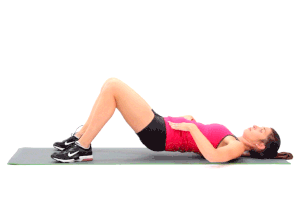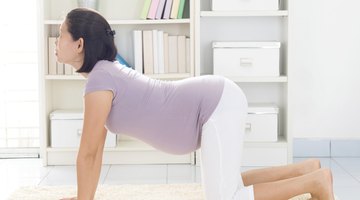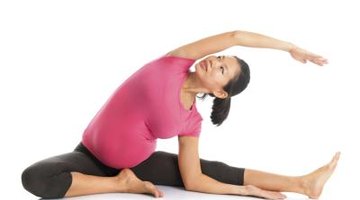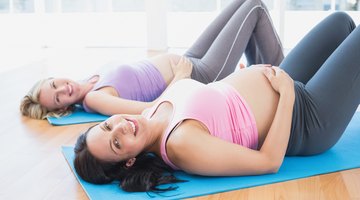Stretches for Hip Pain During Pregnancy
Pregnancy is an exciting time, but sometimes it causes aches and pains as the body changes. Hip and pelvic pain is referred to as pelvic girdle pain, which is closely related to low back pain during pregnancy. Pain in these areas tends to develop in the second or third trimester. Hormone-related joint looseness and postural changes as the baby grows contribute to reduced joint stability, potentially causing mild to debilitating pain in the pelvis, hips, groin and low back.
Women with pelvic girdle pain may have difficulty with activities such as getting out of bed and sitting for long periods. Stretching may help decrease pain and improve function.
Stretches for Hip Pain
Stretching the muscles surrounding the hips and lower back may help relieve tension, promoting proper posture and alignment that might improve function and reduce pain. Major muscle groups that contribute to hip pain include the hamstrings, back muscles and hip flexors, according to a January 2004 "Journal of Bodywork and Movement Therapies" article.
The authors of a March 2013 review article in "Facts, Views and Vision in ObGyn" recommend personalized exercise programs for the treatment of pregnancy-related pelvic girdle pain. The authors further recommend focusing treatment on strengthening weak stabilizer muscles and correcting postural imbalances and movement patterns to support proper pelvic alignment.
Hamstring Stretches
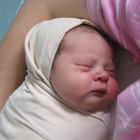
Exercising With Sore Knees After Pregnancy
Learn More
Tight hamstrings -- the large muscles of the back of the thigh -- may contribute to hip or low back pain during pregnancy. Hamstring stretches performed in a standing or seated position are often best after the first trimester of pregnancy.
For a seated, floor hamstring stretch, one leg is extended in front of the body while the other is bent with the foot resting against the inner knee or thigh of the straight leg. Leaning toward the extended leg stretches the hamstrings on that side, which is felt down the back of the thigh.
Seated Piriformis Stretch
The piriformis is a small but important muscle that spans from the top of the thighbone to the tailbone.
It helps regulate movement and stability of the sacroiliac joint -- where the pelvis joins the tailbone. When this joint is unstable during pregnancy, it can affect the piriformis and cause pain and tension in the gluteal area. Piriformis stretches involve crossing one leg over the other and bending forward at the hip until a stretch is felt down the back of the buttocks.
Hip Flexor Stretch

Pregnancy & Numbness in Fingers
Learn More
The hip flexors run along the front of the hip and are responsible for bringing the upper leg toward the front of the body. These muscles can also become tight during pregnancy, potentially contributing to hip pain. Weak abdominal muscles can cause hip flexor tightness, increasing the curve of the low back and disrupting pelvic alignment. Hip flexor stretches are often done while kneeling on one leg with the other foot planted in front of the body, knee bent. Shifting weight over the front leg helps stretch the hip flexors on the opposite side.
Child's Pose
The yoga pose known as child's pose stretches and elongates the muscles along the spine that often get tight during pregnancy and may contribute to poor posture and muscle imbalances, leading to pelvic girdle pain.
Child's pose involves assuming a kneeling position and lowering the body onto the thighs such that the lower body is resting over the feet and ankles and the upper body on the fronts of the thighs. The forehead rests on the floor while the arms are extended outward, palms to the floor. During later pregnancy, the knees are usually spread apart during this pose.
Warnings and Precautions
Talk with your healthcare provider before starting a new stretching routine to be sure it's safe for you.
Avoid bouncing and holding your breath while you stretch, and don't stretch to the point of pain.
If you have increased pain, dizziness or difficulty breathing during any of these activities, stop immediately. Hip, lower back, groin or pelvic pain that does not improve with a change in posture, rest or movement may signal a problem and should be evaluated by your healthcare provider.
Related Articles
- European Spine Journal: European Guidelines for the Diagnosis and Treatment of Pelvic Girdle Pain
- Facts, Views and Vision in ObGyn: Pelvic Girdle Pain During or After Pregnancy: A Review of Recent Evidence and a Clinical Care Path Proposal
- Spine-Health.com: Stretching Exercises for Back Pain During Pregnancy
- Spine-Health.com: Common Causes of Back Pain in Pregnancy
- Spine-Health.com: Sacroiliac Joint and Pregnancy
- Spine-Health.com: Back Muscles and Low Back Pain
- Preventing and Managing Back Pain During Pregnancy; Alicia M. Silva



